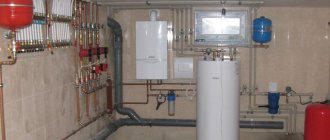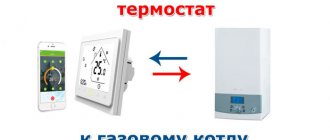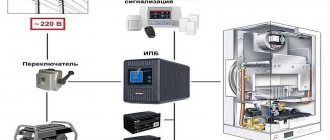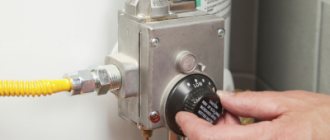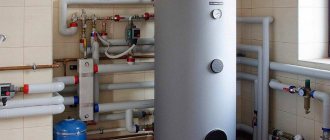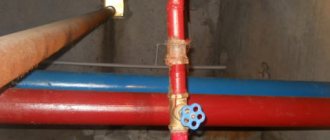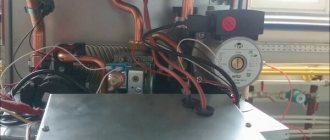Coolant temperature
Boiler clocking
How to set a Baxi boiler to economical mode?
Connecting a room thermostat
Zonal control system
Savings and regular equipment maintenance
Energy prices are regularly rising, gas is no exception. Therefore, owners of wall-mounted gas boilers are increasingly thinking about saving issues. In general, modern gas boilers are quite economical and heating an apartment or country house is quite cheap compared to similar services from commercial organizations. In this article we will look at what factors influence the efficiency of a gas boiler using BAXI as an example.
Types of thermostats for Baxi gas boilers
Devices for Baxi are thermostats compatible with gas boilers of the Italian brand.
In terms of their functions, they do not differ from systems for other gas equipment. Typically, thermostats are distinguished by:
- installation location;
- operating principle;
- control method.
Depending on the location of installation, devices are divided into indoor and outdoor. Indoor ones are used more often than outdoor or outdoor ones, as they do not require protection from difficult weather conditions.
Outdoor options are used in cases where the owner of the house seeks to make the operation of the equipment as accurate and economical as possible. Particularly effective in such cases is the combination of a room thermostat and an outdoor sensor , which Baxi units allow.
According to the principle of operation, the thermostat can be mechanical or electronic. In the first case, you need to manually set the air temperature. In the second , a program is set according to which the boiler changes the operating intensity automatically.
The method of controlling a mechanical thermostat is to manually set the mode by turning a knob or pressing buttons. The electronic or programmable option can operate remotely. In this case, the sensor is located in any part of the room, and control occurs from a remote control, computer or telephone . At the same time, contact with gas equipment remains wired.
Photo 1. Room thermostat model QAA 55 wireless, with modulation, Italy.
Additional useful options
Some thermostat models solve only basic problems without having any additional options.
More advanced samples, in addition to basic functions, are capable of performing some related actions that expand the capabilities and efficiency of the device. For example, in addition to monitoring room temperature, there are options for monitoring weather conditions outside and making adjustments to the heating mode in accordance with them.
In addition, there are other options:
- Several options for room thermal conditions.
- Programming individual settings.
- WiFi Internet access with the ability to remotely program the mode.
- GSM module for working with a smartphone via SMS.
- Protection against unauthorized mode changes (child lock).
- Decorative lighting.
- Protection against overheating or freezing.
- Hydrometer with the function of changing air humidity.
It is up to the owner of the thermostat to decide how necessary these functions are, since they are not available in all models. By choosing the most suitable option, you can immediately determine the list of required options and purchase the desired sample.
What is a room thermostat and why is it needed for a gas boiler?
A thermostat is a device that maintains temperature at a certain, predetermined level..
It is used in many technical and technological installations where it is necessary to maintain certain environmental parameters.
Basically, thermostats are used in heating systems, in internal combustion engines, heating installations and other devices.
For a gas boiler, a thermostat serves as a convenient and useful addition. When the room reaches the desired temperature, it turns off the heating of the coolant, and when it drops, it starts the process again .
The specificity of the device’s operation is to control the temperature of the internal atmosphere in the room (some models simultaneously determine the external temperature, making additional adjustments to the operating mode when it changes).
Own sensors installed in boilers only monitor the temperature of the heating agent. Situations often arise when the coolant is heated to the required value, but the room is cool due to frequently opened doors, windows, etc.
To create a comfortable temperature, you have to often change the operating mode of the boiler, distracting yourself from your business to reconfigure. Using a thermostat relieves the owner of this concern; temperature correction is carried out automatically .
IMPORTANT!
The thermostat allows you to save about 25-30% of space heating costs, which is very attractive for any owner.
Savings and regular equipment maintenance
The basic structure of a traditional gas boiler is almost the same, regardless of the manufacturer. Thermal energy from gas combustion is transferred to the coolant through a heat exchanger. There can be either one or two heat exchangers in the boiler. During operation of any gas boiler, the heat removal surface becomes contaminated with soot deposits from the outside and scale from the inside.
From practice, we can say that it is extremely rare that the system is filled with special prepared water or the water supply system is equipped with a water treatment system. This is especially true for apartment buildings, in which the owners receive a ready-made heating system along with the apartment.
The formation of scale and soot on the walls of the heat exchanger will gradually reduce the heat transfer performance, and more energy will be consumed for heating.
Therefore, annual regular maintenance will definitely affect the efficiency of equipment operation for the better! This especially applies to boilers with bithermic heat exchangers, which, due to their design, are difficult to clean.
Principle of operation
A control board is installed inside the boiler, which controls all the actions of the unit components. It has special contacts, which by default are connected by a special jumper. They are used to connect the thermostat.
While the jumper is in place, the operation of the system is subject to its own logic - the coolant temperature is set, the boiler heats the heating agent to the specified parameters and turns off when they are reached until the water cools down to the lower limit.
When connecting the thermostat, the jumper is removed. The device turns out to be connected to the gap, so all control of the boiler operation passes to it. The work process becomes smoother, frequent starts and stops of heating stop. The air temperature changes more smoothly.
This method of control gives a more successful effect, allowing you to reduce gas consumption and seriously save on heating.
Technology
The connection is made with the boiler and thermostat turned off. According to the instructions for both devices, the corresponding jumper is removed from the control board, and a thermostat is connected to the contacts .
Technologically, this process does not present any difficulty, but for an unprepared person who is afraid to delve into the complex electronics of the equipment, it may seem impossible. In such cases, it is necessary to invite a specialist who can perform qualified installation and connection of the thermostat.
Usually work starts from the boiler:
- With the unit turned off, remove the protective cover to gain access to the control board.
- Remove the jumper on the corresponding contacts according to the instructions.
- Connect the ends of the connecting wire to them.
- The wire is pulled to the location where the thermostat is installed and secured to the wall.
- Connect the device itself, connect it to the power supply.
- Start and configure the operating mode.
IMPORTANT! It is recommended to entrust these actions to a specialist from the service center, otherwise conflict situations and denial of warranty service are possible.
How to choose a Baxi thermostat
Thermostats and sensors for Baxi gas boilers are produced by the Italian company itself , so it is best to choose them. If this is not possible, you need to look for a thermostat that is suitable according to the parameters that are usually indicated in the technical data sheets of the devices. In such cases, it is appropriate to consult a specialist who is well acquainted with the Baxi brand.
Attention! Carefully check the compatibility of the thermostat with the gas boiler for which it is purchased. Remember that devices from the same company interact best with each other.
When choosing a thermostat, it is necessary to consider whether the boiler is used constantly or only occasionally. If the house has an inexpensive model of the unit that rarely works, then a simple regulator with a minimum of functions is enough.
Conversely, if heating and hot water are needed all year round and an expensive unit model is used, it is better to install a programmable thermostat.
And if the cottage uses a “smart home” system , then the ability to control the device via the Internet will be very useful.
This feature is implemented in most advanced models.
The technical requirements for the thermostat are calculated based on the requirements for the operation of the boiler. For example, if the owners go to work in the morning and return only in the evening, a thermostat with a programmer , which will reduce the heating temperature and fuel consumption while no one is in the house.
And also, if the house is geographically located in a cold region, then it is better to purchase a thermostat with frost protection for the system: it automatically turns on the boiler if the air temperature drops to +3°C. For example, the Baxi Magictime Plus room thermostat has such technical characteristics.
Variety of accessories
There are a lot of accessories and additional equipment for Baxi boilers on the market. We list the main ones:
Clear display
- Digital timer. The device allows you to program the operation of utility networks for a certain period. When using it, the boiler will turn on/off at the time specified by the consumer. You can use this device not only for programming heating, but also for boilers.
- Room thermostat, or thermostat. This device maintains the set temperature and allows you to control the microclimate. A boiler equipped with a programmer will operate in automatic mode. In this case, no intervention from the consumer in the operation of the unit is required.
- Outdoor temperature sensor. To maintain heat in the house, it is necessary to take into account the temperature of the outside air. The delta (difference) between room and street temperatures directly determines the power with which the boiler must operate. The outside temperature sensor allows you to maintain a constant mode no matter what the weather is outside the window.
- Room temperature sensor. It is recommended to install it together with the device described above. Both devices, working in pairs, guarantee the so-called self-adaptation of the boiler.
- Digital control panel. This is a real highlight. You can install it in a convenient place. With its help, not only control, but also diagnostics of the system occurs. This device can be used in conjunction with the programmer or separately from it.
These are not all the accessories that can be connected to Baxi indoor gas boilers. You should dwell in more detail on the most common device - a thermostat, or thermostat.
Errors in the BAXI Eco Four 24 F gas boiler
Error codes can be found in the operating instructions for the device.
The Baxi Ecofor gas boiler is equipped with a self-diagnosis system. If any faults are detected, the device pauses operation and signals a fault. An error code appears on the display. This makes repairs easier.
The most common problems that occur are:
- E01 – burner goes out. There are many reasons: ignition error, sensor failure, lack of gas.
- E02 – heat exchanger overheating. Most often it occurs due to the accumulation of plaque on pipes.
- E03 – fan failure. The device needs to be replaced.
- E05 – Exhaust temperature sensor failure.
- E06 – DHW temperature sensor failure.
- E10 – pressure in the heating system has dropped. A possible reason is a leak in the boiler itself or the pipes.
- E25-26 – pump failure. The same code may also indicate a sensor malfunction.
- E35 – mixing of media. Occurs when moisture appears on the board, sensor breakdown, or stray flame occurs.
- E26 – the network voltage is insufficient for the device to operate.
When the code appears on the screen, press the “R” button and hold it until the error is reset. If after this the message appears on the display again, the malfunction is real and not caused by an accidental failure. You need to call a specialist. Self-repair of a gas boiler is strictly prohibited.
You can use the restart option no more than 5 times, then the device is locked.
How to install correctly
Installing the device is not difficult. The main task is to choose the right location.
Experts recommend placing thermostats in living rooms, avoiding installation in hallways or kitchens.
Otherwise, the boiler begins to provide the microclimate of these particular areas of the house, and the temperature in the rooms is set with distortions.
The optimal installation height is considered to be 1.5 m from the floor, away from heating devices and household appliances that generate heat.
NOTE!
It is necessary to ensure that there are no drafts in the control area and an even and steady flow of fresh air is ensured.
We calculate how much electricity a gas boiler consumes per hour, day and month
The units of measurement for electricity consumption by a gas boiler, like any other electrical appliance, are Watts (W). In technical documentation it is usually indicated as rated electrical power.
For example, the well-known wall-mounted dual-circuit Vaillant turboFIT VUW 242/5-2 consumes up to 140 W per hour. It is easy to calculate its maximum consumption:
- Per day – 24 (hours) * 140 (W) = 3,360 W or 3.36 kW. In value terms (at the current tariff of 5.38 rubles per 1 kWh) – 3.36 * 5.38 = 18.07 rubles/day.
- Per month – 30 (days) * 3.36 (daily consumption, kW) = 100.8 kW. In value terms – 100.8 * 5.38 = 542.3 rubles/month.
- For the heating season (suppose from October 15 to March 31) - 136 (days) * 3.36 (daily consumption, kW) = 456.96 kW. In value terms – 456.96 * 5.38 = 2,458.4 rubles/season.
However, these are only the maximum possible indicators; in practice, a gas boiler does not operate 24/7, and it consumes electricity unevenly: when igniting it, much more is spent. In reality, the values depend on weather conditions and heating mode, usually 50-70% of the maximum values.
It is impossible to determine exactly how much electricity a gas boiler consumes using a theoretical method (which is why only the maximum value is indicated in the characteristics); metering devices (electric meters) are used for accurate calculations.
According to reviews from owners, regardless of the power of the boiler, the average monthly electricity consumption is 40-80 kW.
How to calculate how much gas a household gas boiler consumes
Consumption table of famous models, according to their passports
| Model | Max power consumption, W |
| BAXI ECO-4s 24F | 130 |
| Vaillant turboFIT VUW 242/5-2 | 140 |
| Viessmann Vitopend 100-W A1HB001 24 | 120 |
| Bosch Gaz 6000 W WBN 6000- 12 | 150 |
| Buderus Logamax U072-24 | 130 |
| Ariston CLAS X SYSTEM 24 FF NG | 108 |
Advantages
Thus, we have completely disassembled the principle of operation of a heating system using an electronic or mechanical thermostat. This is a very convenient solution for several reasons:
- Eliminates the need to manually adjust the water temperature to keep the room at a comfortable temperature.
- When using a wireless thermostat, there is also no need to adjust the boiler itself; this is extremely convenient if the boiler is placed in a separate room - the boiler room.
- It becomes possible to set different temperatures for day and night, this significantly saves gas at night.
What materials are needed for connection
Connection materials are usually supplied with the thermostat. This is, first of all, the device itself, as well as the installation cable and fasteners . With their help, the device is connected to a gas boiler and fixed to the wall.
What tools are required for installation
To connect the thermostat you may need:
- screwdriver;
- drill;
- side cutters;
- thermometer.
use side cutters to strip the ends of the thermostat wires, but as a rule, they already have terminals that are screwed to the contacts of the gas boiler for the remote thermostat.
A drill is needed for the holes in the wall into which the dowels are installed. Screws are screwed into them , onto which the device is attached. need for dowels if the wall is wooden.
A thermometer will be needed to check the air temperature after starting the thermostat.
Connection procedure
During the connection period, both devices should not work. To connect the thermostat and gas boiler, you must study the technical data sheets of both devices and follow the diagrams and connection instructions. The ends of the cable for the thermostat must be attached to the contacts of the gas boiler intended for this purpose.
Then the cable must be pulled along the wall to the location where the thermostat is installed. After this, at the selected point (usually it is in the coldest living room), the device is screwed to the wall. Finally, the device is configured and tested.
How to check the operation of the device
To test the device, you must set the maximum temperature. Then you need to turn on the gas boiler and bring it to the mode with maximum efficiency (efficiency).
Once a comfortable temperature is reached, you need to accurately measure it next to the thermostat and set it as a threshold for turning off.
Then, within an hour, you need to monitor whether the thermostat turns on the heater when the air cools down within 0.5-2 °C . If this happens, then the devices are working correctly.
Installation Features
The installation of an expansion tank in the heating system depends on the type of the latter. As mentioned above, heating can be implemented in closed and open ways.
Below we will look at how to connect the tank with your own hands in both cases.
Open heating system diagram
Open system
Open heating is essentially one large vessel with specific convection currents inside.
The installation of a heating expansion tank in this case, like all other heating devices, must ensure:
- Rapid rise of the coolant heated by the boiler to the top point of the heating structure, as well as its natural circulation through the heating devices.
- Free and unimpeded upward movement of air bubbles.
For these reasons, the installation of this device is carried out at the highest point of the structure. Most often in private homes, these containers are located in the attic or at the top of the accelerating manifold (in a single-pipe system).
It must be said that the tank itself for the open system also differs in design:
- Does not require shut-off valves;
- Does not require a rubber membrane or even a lid.
In this case, the expansion tank is a simple container into which, if necessary, you can add a bucket of water to replace the evaporated water. As a rule, the price of such a device is equal to a pair of electrodes and the cost per square meter of a steel sheet several millimeters thick.
Closed heating system diagram
Closed system
If the design is implemented according to a closed scheme, then the installation of the expansion tank of the heating system has a number of features, which we will familiarize ourselves with below:
- The most optimal place to connect the device is the area where the coolant flow is closest to laminar and there are no turbulences. Therefore, the obvious solution is to install it in front of the heating circulation pump. As for the height of the location, it does not matter, since the task of the device, as mentioned above, is to compensate for thermal expansion and dampen water hammer.
- The location of the tank in space is of great importance. Ideally, the liquid should enter the container from above, which will completely remove air from the liquid compartment.
- The volume of the device must be at least a tenth of the volume of the total liquid in the system. You can calculate the volume of water based on the power of the boiler - 15 liters of liquid are taken per kilowatt.
Note! Often, heating boilers are equipped with expansion tanks and even circulation pumps. Therefore, before you go shopping for devices, you should make sure that you need them
Expansion tank connected to plastic pipes
As an example, let's look at how to install a membrane tank.
So, the instructions look like this:
- If the connection is made to an existing heating system, then first of all you need to turn off all equipment and drain the water from the batteries. In order for the liquid to flow better, you should open the Mayevsky taps.
- If plastic radiators are used, then installation should be carried out through a detachable mounting element called “American”. The first part of it is screwed to the tank, and the second is soldered to the pipe. Then both parts are connected.
“American” for connecting the tank
- Then you need to cut the heating pipe and install a tee. to which the pipe from the tank is connected.
- While there is no water in the batteries, you need to remove the coarse filter and wash it.
- After installing all the elements in their places, you need to open the taps and fill the radiators with water. In this case, the pressure should rise to 1.2-1.3 kPa.
- At the end of the work, you should bleed off the air and close the Mayevsky taps.
Advice! It is advisable to install a tap in front of the expansion tank. This will allow you to repair the device without draining the batteries.
After completing all the above steps, you can turn on the boiler.
Central thermostat
This type of programmer is installed in the house and connected to the heating device either by wires or via wireless networks. The latter are more expensive, but more convenient and effective.
The main advantage of wireless thermostats is the ability to install them anywhere. At the same time, they do not disturb the interior, and their installation does not require any complex devices or destruction of building structures. The case is attached using self-tapping screws, after which all the necessary electronics are connected and the necessary parameters are set. Such a device can operate remotely. It can be used not only with gas, but also with solid fuel boilers.
About the mechanical thermostat
An important point, those who have chosen a more durable and reliable mechanical thermostat for their home should remember that this device does not require an electrical connection or batteries. However, during the work on connecting it, it will also not be possible to avoid fiddling with the wires. But in this case we are talking about wires that ensure communication between the device and controlled climate control equipment.
Mechanical room thermostat IMIT-Ta3n
The mechanical thermostat is connected to the boiler using a 2-wire connection.
Popular mechanical thermostat Ballu BMT-1
The video shows how to connect the Ballu BMT-1 thermostat.
Tips for DIYers
The benefits of installing a thermostat are obvious. The payback of the devices is also beyond doubt. Nevertheless, the desire to save money on installing such a useful device still remains strong. This often encourages home DIYers to do everything themselves. And not only to install the device yourself, but also to assemble it from scrap materials.
Installation process
Theoretically, it is possible to make a thermostat with your own hands. To do this, you will need a thermistor that reduces resistance when heated. Then another resistor is connected to the network, with the help of which the temperature will be programmed. The 2I-NOT element will operate in inverter mode, and voltage will be supplied to it. A capacitor is connected to it and to the trigger. To control the relay, the galvanic isolation on the triac is enhanced. The device can be made either on a mole rat or on a printed circuit board.
Using such a simple circuit, you can assemble a thermostat for almost any boiler. But is it worth interfering with the operation of high-tech equipment? It is up to the home owner to decide. Experts do not advise experimenting with homemade devices, especially since you can find accessories for any boiler on the market.
Price range
The cost of a thermostat depends on its design and set of functions. Conventional mechanical devices are relatively inexpensive - from 1000 rubles .
Electronic devices with programming, remote control and other functions can cost up to 10,000 rubles and more. There are many price options, which allows you to choose an affordable device and be able to more accurately set the temperature in the house.
Zonal control system
Such a system provides for individual temperature control in each room separately by installing controlled thermal heads on each radiator. That is, depending on the air temperature in a particular room, the amount of coolant in the radiator will be regulated, and the boiler will turn on only when necessary. The use of such regulation will provide maximum savings (about 30%) and comfort in the room. The only disadvantage of such a system is its cost.
Recommendations for use
In order for the heating system to operate economically and create maximum comfort in the home, the following recommendations should be taken into account:
- if all household members are at work or school for a long period, an economical operating mode can be programmed for this time;
- when leaving home for a long time, you need to set the heating to minimum and install new batteries;
- It is better to change the batteries in the programmer for new ones in advance, without waiting until they are completely discharged;
- It is advisable to connect a voltage stabilizer to the thermostat and gas boiler.
A thermostat is a useful device that will save money and create comfort and coziness in your home. It will make it easier to operate the gas boiler and extend its service life.

